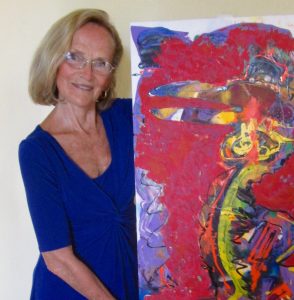As visual artist and author (The Butcher’s Daughter) Florence Grende explained to the attentive audience gathered in her living room last Sunday afternoon for the first in what might become a series of ekphrasis readings here in San Miguel de Allende, the term “ekphrasis” may be a relatively new entry in the Merriam Webster dictionary, but the practice – using vivid, often dramatic, words to comment on a piece of visual art – is actually ancient.
“One of the earliest and most commonly cited forms of ekphrasis,” Florence told the group, “occurs in The Iliad, when Homer provides a long and discursive account of the elaborate scenes embossed on the shield of Achilles. It should be no surprise, then, that the term ekphrasis derives from Greek, where it literally means ‘description.’”
Although, generally speaking, virtually any type of artistic medium may be the actor of – or the subject of – ekphrasis (that is to say, one medium’s attempt to illuminate another medium by describing its essence and in doing so relate more directly to the audience), the ekphrasis event at Florence’s focused on her vibrant abstract paintings, many of which are displayed throughout her home.
As Florence states, her paintings are begun with a base of color “flung freely here and there” … and then she waits … “for an image to call out, usually a figure.” In these figures she gives voice to “the interplay between conscious and subconscious, between that which is known and that which is hidden.”
For this ekphrasis event, four San Miguel authors – all women, retired from their previous careers in Norteamérica — had chosen in advance one (or more) each of Florence’s paintings that prompted them to write an original piece of poetry or prose to present to the group on this special Sunday. It was performance art — a form of modern-day magical alchemy, combining spoken words inspired by abstract images on canvas — in front of a live, appreciative audience.
Authors Ellen Akerman, Catherine Marenghi, and MaryKatherine Wainwright read poems that brought their chosen paintings alive. I read a sad, true story I titled “Farmette,” about my brief experience living in a farming community in northern New Mexico and the time my beloved chickens and ducks were attacked by evil weasels.

It may be that this authors group has started something here. Perhaps in the future we can take our “ekphrasis act” into some of San Miguel’s many art galleries, as I remember doing successfully some years ago in Taos. Time will tell. Or, as everyone always says here in Mexico regarding future plans, “Vamos a ver…”

What fun! Let’s hope this starts us all on an Ekphrasis adventure however it formats.
Yes, Theresa dear, and maybe there will be more ekphrasis events in Taos, too.
Thanks for introducing me to a fascinating tradition. I loved your story and the painting also. I hope SMAC is able to do this again!
I love learning new words. And new concepts. Thanks, Bonnie.
(now let’s just hope I actually remember it!)
I have no doubt that you’ll be able to remember it, April dear! Now, repeat after me: ek-phra-sis, ek-phra-sis, ek-phra-sis! 🙂
Dear Bon,
What a wonderful experience. I want to do this in my classroom. You are creating a work of art inspired by a work of art. I think it is fantastic.
Love,
Paul
Thanks, Paul darling! I’m sure your students will really get “into” it! It’s so exciting to let a work of art speak to you and then (like a stenographer) take down what the artwork says. Let me know how it goes with your class. — xx
Love the concept! Perhaps my friend’s outsider art collection could be a venue/inspiration in the future!
Thanks, Suzanne. Yes, that’s something to consider. Hasta pronto!